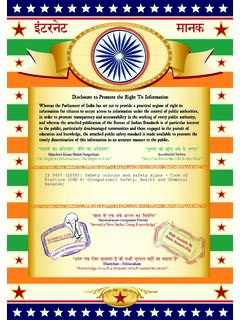Transcription of Subject: CREW RESOURCE MANAGEMENT Date: 1/22/04 …
1 subject : crew RESOURCE MANAGEMENT Date: 1/22/04 AC No: 120-51E. TRAINING Initiated By: AFS-210 Change: 1. PURPOSE. This advisory Circular (AC) presents guidelines for developing, implementing, reinforcing, and assessing crew RESOURCE MANAGEMENT (CRM) training for flight crewmembers and other personnel essential to flight safety. CRM training is designed to become an integral part of training and operations. These guidelines were originally intended for Title 14 of the Code of Federal Regulations (14 CFR) part 121 certificate holders who are required by regulation to provide CRM training for pilots and flight attendants, and dispatch RESOURCE MANAGEMENT (DRM) training for aircraft dispatchers.
2 Fractional ownership program managers, required by 14 CFR part 91, subpart K to provide CRM training to pilots and flight attendants, and those 14 CFR part 135 operators electing to train in accordance with part 121 requirements, should also use these guidelines. Certificate holders and individuals operating under other operating rules, such as parts 91 (apart from subpart K), 125, and part 135 operators not electing to train in accordance with part 121, and others, should find these guidelines useful in addressing human performance issues. This AC presents one way, but not necessarily the only way, that CRM training may be addressed. CRM training focuses on situation awareness, communication skills, teamwork, task allocation, and decisionmaking within a comprehensive framework of standard operating procedures (SOP).
3 2. CANCELLATION. AC 120-51D, crew RESOURCE MANAGEMENT Training, dated 2/8/01, is cancelled. 3. PRINCIPAL CHANGES. Operators of fractional ownership programs under part 91, subpart K, are now required to provide CRM training to pilots and flight attendants, and are mentioned in the PURPOSE paragraph, above. Under paragraph 12 of this AC, the subparagraph on Briefings has been expanded to address safety and security concerns, including evacuation and hijack. A new subparagraph under paragraph 16, entitled crew Monitoring and Cross-Checking, emphasizes the critical role of the pilot-not-flying (PNF) as a monitor. Monitoring is always essential, and particularly so during approach and landing when controlled flight into terrain (CFIT) accidents are most common.
4 Accordingly, previous references to PNF have been changed to pilot monitoring (PM), in accordance with government and industry preference. In appendix 3, attempted hijack has been included as the most serious level of passenger interference requiring effective crew response, and has been included as an appropriate CRM training topic. Minor editorial changes have also been made in AC 120-51E 1/22/04 . this revision. Text that has been changed from AC 120-51D is marked with a vertical bar in the left margin. 4. RELATED REGULATIONS (Title 14 of the Code of Federal Regulations). Part 91, section ; Part 121, subpart N and O, part 135, subparts E and H; sections , , , , , , , , , and ; Special Federal Aviation Regulation (SFAR) No.
5 58. 5. DEFINITIONS. The human factors safety challenge and the CRM training response may be defined as follows: a. Human Factors. The multidisciplinary field of human factors is devoted to optimizing human performance and reducing human error. It incorporates the methods and principles of the behavioral and social sciences, engineering, and physiology. It is the applied science that studies people working together in concert with machines. It embraces variables that influence individual performance and variables that influence team or crew performance. It is recognized that inadequate system design or inadequate operator training can contribute to individual human error that leads to system performance degradation.
6 Further, it is recognized that inadequate design and MANAGEMENT of crew tasks can contribute to group errors that lead to system performance degradation. b. CRM Training. The application of team MANAGEMENT concepts in the flight deck environment was initially known as cockpit RESOURCE MANAGEMENT . As CRM training evolved to include flight attendants, maintenance personnel and others, the phrase crew RESOURCE MANAGEMENT was adopted. (1) As used in this AC, CRM refers to the effective use of all available resources: human resources, hardware, and information. Other groups routinely working with the cockpit crew , who are involved in decisions required to operate a flight safely, are also essential participants in an effective CRM process.
7 These groups include but are not limited to: (a) Aircraft dispatchers. (b) Flight attendants. (c) Maintenance personnel. (d) Air traffic controllers. (2) CRM training is one way of addressing the challenge of optimizing the human/machine interface and accompanying interpersonal activities. These activities include team building and maintenance, information transfer, problem solving, decisionmaking, maintaining situation awareness, and dealing with automated systems. CRM training is comprised of three components: initial indoctrination/awareness, recurrent practice and feedback, and continual reinforcement. Page 2 Par 6. 1/22/04 AC 120-51E. 6. RELATED READING MATERIAL. a. AC 120-35B, Line Operational Simulations: Line-Oriented Flight Training, Special Purpose Operational Training, Line Operational Evaluation.
8 B. AC 120-48, Communication and Coordination Between Flight Crewmembers and Flight Attendants. c. AC 120-54, Advanced Qualification Program. d. AC 120-71, Standard Operating Procedures for Flightdeck Crewmembers e. AC 121-32, Dispatch RESOURCE MANAGEMENT Training. NOTE: Many ACs may be downloaded free of charge from the following FAA public Web site: Click on Regulations & Policies Click on advisory Circulars Free ACs may be obtained by mail from: Department of Transportation Subsequent Distribution Office, Ardmore East Business Center 3341 Q 75th Ave. Landover, MD 20785. f. Guidelines for Situation Awareness Training, NAWCTSD/FAA/UCF Partnership for Aviation Team Training. This document may be viewed, downloaded, or printed at the following Web site: g.
9 Controlled Flight into Terrain Education and Training Aid, Flight Safety Foundation, International Civil Aviation Organization (ICAO), and the FAA. This document may be viewed, downloaded, or printed at the following Web site: h. International Civil Aviation Organization (ICAO) Annex 13 on Human Factors. This document may be obtained from ICAO Document Sales Unit, Montreal, Quebec, Canada, 514-954- 8022. i. For detailed information on the recommendations made in this AC, the reader is encouraged to review crew RESOURCE MANAGEMENT : An Introductory Handbook published by the Federal Aviation Administration (FAA) (Document No. DOT/FAA/RD-92/26). Additional background material can be found in Cockpit RESOURCE MANAGEMENT Training: Proceedings of a NASA/MAC Workshop, 1987.
10 The national aeronautics and Space Administration (NASA) Conference Proceedings (CP). number is 2455. The national Plan for Aviation Human Factors defines research issues related to Par 6 Page 3. AC 120-51E 1/22/04 . crew coordination and training. Copies of the preceding publications may be purchased from the national Technical Information Service, Department of Commerce, 5285 Port Royal Road, Springfield, Virginia 22161. The telephone numbers for national Technical Information Service are: (800) 553-6847 (553-NTIS), and (703) 605-6000; fax: (703) 605-6900. j. Descriptions of relevant research findings, methodological issues, and organizational experience can be found in Helmreich, , and Wilhelm, , (1991) Outcomes of CRM Training.













